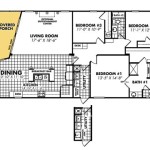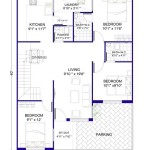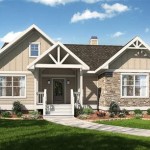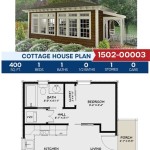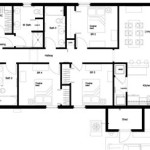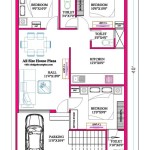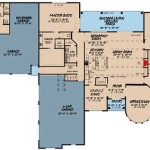One Story Home Plans With Wrap Around Porch: A Comprehensive Guide
The allure of a one-story home plan paired with a wrap-around porch is timeless. These designs offer a blend of accessibility, comfort, and aesthetic appeal that resonates with a wide range of homeowners. A wrap-around porch extends the living space outdoors, creating an inviting atmosphere for relaxation, entertainment, and connection with nature. This article explores the various aspects of one-story home plans with wrap-around porches, providing insights into their advantages, design considerations, and practical implications.
One-story home plans, often referred to as ranch-style homes, prioritize horizontal living. This means that all essential living spaces, including bedrooms, bathrooms, the kitchen, and living areas, are located on a single level. This feature is particularly beneficial for individuals with mobility challenges, families with young children, and those who prefer the convenience of avoiding stairs. The addition of a wrap-around porch further enhances the livability of these homes by providing an accessible and versatile outdoor space.
A wrap-around porch encircles the home, or at least extends along two or more sides, creating a continuous outdoor area. This design element not only adds to the aesthetic charm of the house but also provides multiple points of access to the interior, allowing for better ventilation and natural light penetration. The expansive nature of the porch offers ample space for various activities, from enjoying morning coffee to hosting evening gatherings.
Key Point 1: Accessibility and Universal Design Considerations
One of the primary appeals of combining a one-story home plan with a wrap-around porch lies in its inherent accessibility. The absence of stairs makes the home suitable for individuals of all ages and abilities. For homeowners planning for long-term residency, designing with universal design principles in mind is crucial. Universal design focuses on creating spaces that are usable by everyone, regardless of their physical capabilities.
Within the context of a one-story home with a wrap-around porch, accessibility considerations extend to the design of the porch itself. Ramps, rather than steps, can be incorporated to provide smooth transitions between the porch and the surrounding landscape. Wider doorways leading from the porch into the interior can accommodate wheelchairs and walkers. The surface material of the porch should be slip-resistant to prevent accidents, especially in wet conditions. Proper lighting is also essential to ensure safe navigation during nighttime hours.
Inside the home, accessibility considerations may include wider hallways and doorways, grab bars in bathrooms, and adaptable kitchen layouts. These features, combined with the ease of access provided by the one-story layout and the wrap-around porch, create a home that is truly inclusive and adaptable to the changing needs of its occupants. By prioritizing accessibility, homeowners can ensure that their home remains comfortable and functional for years to come.
Furthermore, the visual aspect of accessibility should also be considered. Clear signage, contrasting colors to delineate changes in elevation, and intuitive layouts can all contribute to a more user-friendly environment for individuals with visual impairments. Thoughtful planning that incorporates these elements can significantly enhance the overall accessibility and usability of the home.
Key Point 2: Design Styles and Architectural Integration
One-story home plans with wrap-around porches are adaptable to a wide range of architectural styles, allowing homeowners to create a residence that reflects their personal preferences and complements the surrounding environment. From traditional farmhouse designs to modern coastal styles, the possibilities are virtually endless. The key is to ensure that the design elements of the house and the porch are cohesive and harmonious.
Farmhouse-style homes often feature wide, welcoming porches, often constructed with natural materials such as wood and stone. These porches typically incorporate elements such as rocking chairs, porch swings, and decorative railings, creating a cozy and inviting atmosphere. The architectural details of the house, such as board-and-batten siding, gabled roofs, and exposed rafters, further enhance the farmhouse aesthetic.
Coastal-style homes, on the other hand, may feature lighter colors, such as white, blue, and gray, to reflect the coastal environment. The porches often incorporate elements such as nautical-themed lighting fixtures, woven furniture, and panoramic views of the ocean or waterfront. The architectural details of the house may include shingle siding, large windows, and open floor plans to maximize natural light and ventilation.
Modern home plans can also incorporate wrap-around porches, albeit with a more contemporary twist. Clean lines, minimalist details, and innovative materials are often used to create a sleek and sophisticated look. The porches may feature elements such as glass railings, built-in seating, and outdoor fireplaces, creating a seamless transition between the indoor and outdoor living spaces. The architectural details of the house may include flat roofs, large expanses of glass, and geometric forms.
Regardless of the architectural style chosen, it is crucial to consider the proportions and scale of the porch in relation to the house. The porch should be appropriately sized to complement the overall design and avoid overwhelming the structure. The materials used for the porch should also be carefully selected to ensure durability, weather resistance, and aesthetic appeal.
Key Point 3: Functionality and Utilizing the Wrap-Around Porch
The functionality of a wrap-around porch extends far beyond simply providing a covered outdoor space. It can serve as an extension of the living area, accommodating a variety of activities and enhancing the overall livability of the home. Careful planning is essential to maximize the potential of the porch and create a space that is both functional and enjoyable.
One of the primary functions of a wrap-around porch is to provide a space for relaxation and recreation. This can include areas for lounging, reading, and socializing. Comfortable seating, such as sofas, chairs, and hammocks, can be arranged to create inviting areas for relaxation. Outdoor rugs, throw pillows, and decorative accessories can further enhance the comfort and aesthetic appeal of the space.
The porch can also serve as an outdoor dining area, providing a pleasant setting for enjoying meals with family and friends. A large table and chairs can be arranged to accommodate a group of people, and outdoor lighting can be installed to create a warm and inviting atmosphere. A built-in grill or outdoor kitchen can further enhance the functionality of the dining area.
For homeowners who enjoy gardening, a wrap-around porch can provide an ideal space for creating a container garden. Potted plants, hanging baskets, and vertical gardens can be used to add color and texture to the porch, creating a miniature oasis. The porch can also serve as a staging area for larger gardening projects.
In addition to these specific functions, a wrap-around porch can also serve as a transition space between the indoor and outdoor environments. It can provide a sheltered area for removing shoes and coats before entering the house, and it can serve as a buffer against the elements. The porch can also provide a sense of privacy and seclusion, shielding the interior of the house from the outside world.
In order to fully utilize the potential of a wrap-around porch, it is important to consider the climate and weather conditions of the region. In areas with hot summers, shade structures such as awnings, pergolas, or trees can be used to provide relief from the sun. In areas with cold winters, the porch can be enclosed with screens or windows to create a three-season room. The orientation of the porch should also be considered to maximize sunlight exposure and minimize wind exposure.
Overall, one-story home plans with wrap-around porches offer a unique combination of accessibility, aesthetic appeal, and functionality. By considering the design principles and practical implications outlined in this article, homeowners can create a residence that is both comfortable and inviting.
The enduring popularity of these home styles underscores the desire for homes that embrace both indoor and outdoor living. A well-designed one-story home with a wrap-around porch can be a haven for relaxation, entertainment, and connection with nature, providing a comfortable and adaptable space for years to come.

One Story Floor Plans With Wrap Around Porch Barndominium Farmhouse House

Wrap Around Porch House Plans For A 4 Bedroom Country Home

Home Porch Single Story House Plans With Wrap Around Ideas Ranch Style Farmhouse Diy

Ardmore Park Country Home House Plans Farmhouse Floor Style
:max_bytes(150000):strip_icc()/tideland-haven_0-67e696598afc46328367d3653cfd9724.jpg?strip=all)
13 House Plans With Wrap Around Porches

Farmhouse Style House Plans For The Modern Family

One Story House Plans With Porches Dfd Blog

Must Have One Story Open Floor Plans Blog Eplans Com

Lowcountry Style House Plan With Full Wrap Around Porch

This Is Perfect House For Me All One Story And A Wrap Around Porch Yes Rabbithouses Barndominium Floor Plans Farmhouse

